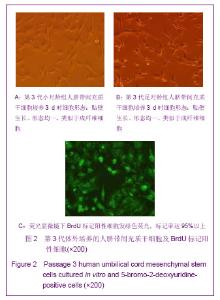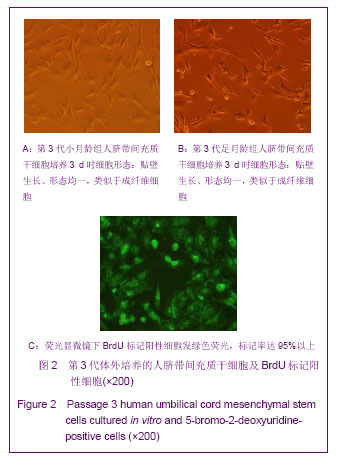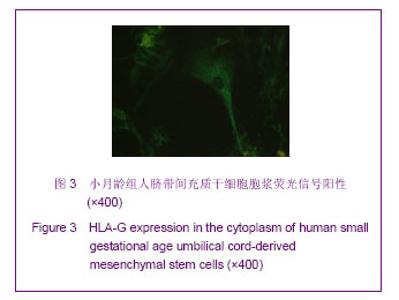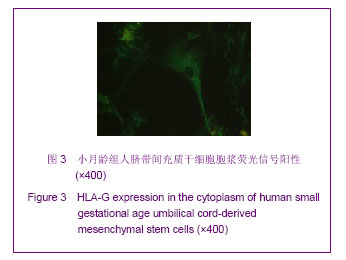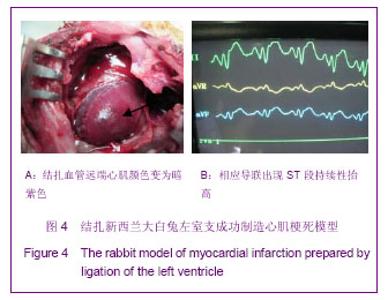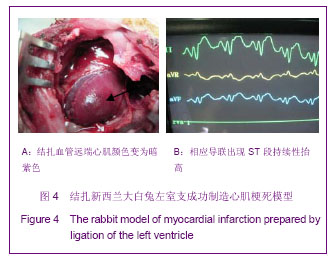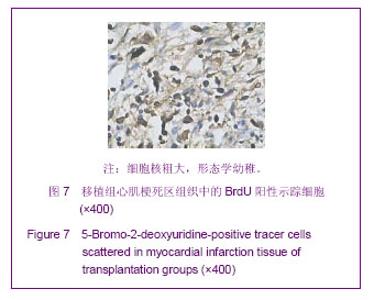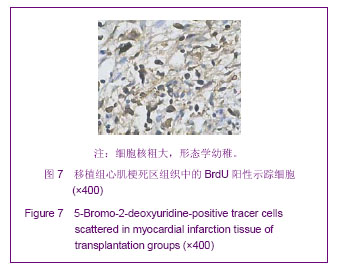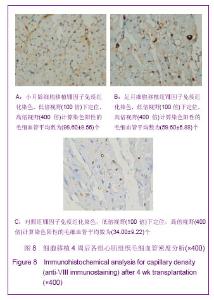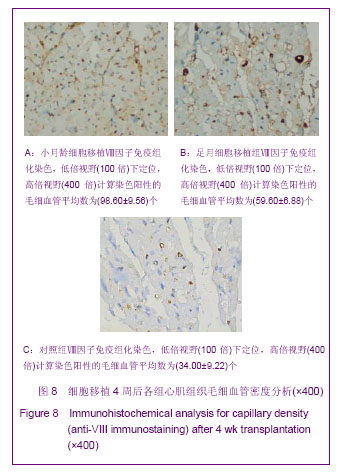Chinese Journal of Tissue Engineering Research ›› 2013, Vol. 17 ›› Issue (49): 8520-8526.doi: 10.3969/j.issn.2095-4344.2013.49.009
Previous Articles Next Articles
Transplantation of human umbilical cord mesenchymal stem cells at different gestational age for myocardium revascularization after myocardial infarction
Wu Li-ping1, Cai Li1, Tao Jian-hong1, Cao Mei2, Zhu Yi-fan3, Li Jin-song1, Wang Yan4
- 1Department of Cardiology, 2Clinical Laboratory, 3Organ Transplantation Center, 4Department of Hematology, Sichuan Provincial People’s Hospital, Chengdu 610072, Sichuan Province, China
-
Revised:2013-09-14Online:2013-12-03Published:2013-12-03 -
Contact:Cai Li, Master, Professor, Master’s supervisor, Department of Cardiology, Sichuan Provincial People’s Hospital, Chengdu 610000, Sichuan Province, China scsrmyyyb@163.com -
About author:Wu Li-ping★, Studying for master’s degree, Physician, Department of Cardiology, Sichuan Provincial People’s Hospital, Chengdu 610072, Sichuan Province, China wlp3124558@yahoo.com.cn -
Supported by:the Applied Basic Research Program of Sichuan Province, No. 2009JY0094*; the Youth Foundation of Sichuan Province, No. 2011JQ0018*
CLC Number:
Cite this article
Wu Li-ping, Cai Li, Tao Jian-hong, Cao Mei, Zhu Yi-fan, Li Jin-song, Wang Yan. Transplantation of human umbilical cord mesenchymal stem cells at different gestational age for myocardium revascularization after myocardial infarction[J]. Chinese Journal of Tissue Engineering Research, 2013, 17(49): 8520-8526.
share this article
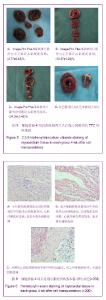
2.4 各组心肌梗死面积 细胞移植4周后心肌组织的TTC特殊染色显示:小月龄细胞移植组心肌梗死面积(9.77±2.43)%和足月细胞移植组心肌梗死面积(15.87± 1.23)%均小于对照组(24.29±3.48)%(P < 0.01),两移植组间差异有显著性意义(P < 0.05),见图5。 2.5 心肌组织的苏木精-伊红染色 人脐带间充质干细胞移植后4周各组心肌组织的苏木精-伊红染色,可见:小月龄细胞移植组心肌组织梗死区中有较多心肌细胞存活,心肌纤维化程度低,仅见少量炎细胞浸润。足月细胞移植组梗死区中亦有较多心肌细胞存活,出现脂肪变性现象,心肌纤维化程度较低,见多量炎细胞浸润。对照组心肌组织梗死区中肌纤维结构消失,代之纤维瘢痕组织,大量炎细胞浸润,见图6。"
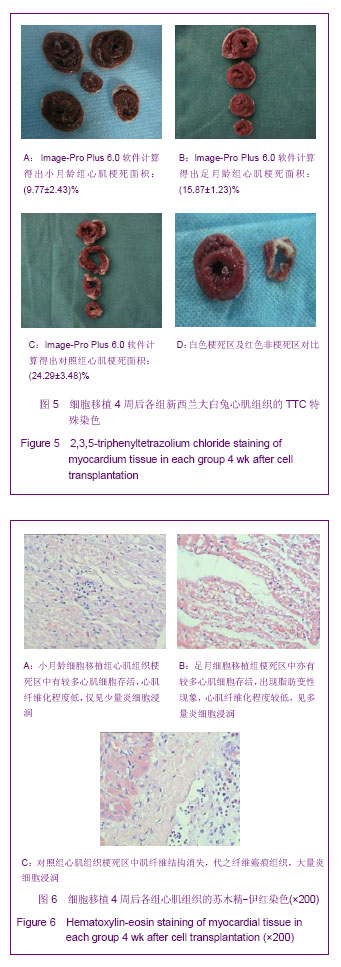
| [1] Kadner A, Zund G, Maurus C,et al. Human umbilical cord cells for cardiovascular tissue engineering: a comparative study. Eur J Cardiothorac Surg. 2004;25(4):635-641.[2] Qian Q, Qian H, Zhang X,et al. 5-Azacytidine induces cardiac differentiation of human umbilical cord-derived mesenchymal stem cells by activating extracellular regulated kinase.Stem Cells Dev. 2012;21(1):67-75. [3] Cao FJ, Feng SQ. Human umbilical cord mesenchymal stem cells and the treatment of spinal cord injury. Chin Med J (Engl). 2009;122(2):225-231.[4] Hsieh JY, Fu YS, Chang SJ,et al. Functional module analysis reveals differential osteogenic and stemness potentials in human mesenchymal stem cells from bone marrow and Wharton's jelly of umbilical cord.Stem Cells Dev. 2010;19(12): 1895-1910.[5] Han Y, Chai J, Sun T,et al. Differentiation of human umbilical cord mesenchymal stem cells into dermal fibroblasts in vitro.Biochem Biophys Res Commun. 2011;413(4):561-565.[6] Wang L, Ott L, Seshareddy K,et al. Musculoskeletal tissue engineering with human umbilical cord mesenchymal stromal cells.Regen Med. 2011;6(1):95-109. [7] Chen MY, Lie PC, Li ZL,et al. Endothelial differentiation of Wharton's jelly-derived mesenchymal stem cells in comparison with bone marrow-derived mesenchymal stem cells.Exp Hematol. 2009;37(5):629-640.[8] Wang L, Tran I, Seshareddy K,et al. A comparison of human bone marrow-derived mesenchymal stem cells and human umbilical cord-derived mesenchymal stromal cells for cartilage tissue engineering.Tissue Eng Part A. 2009;15(8): 2259-2266.[9] Wang HS, Hung SC, Peng ST,et al. Mesenchymal stem cells in the Wharton's jelly of the human umbilical cord.Stem Cells. 2004;22(7):1330-1337.[10] Karahuseyinoglu S, Cinar O, Kilic E,et al. Biology of stem cells in human umbilical cord stroma: in situ and in vitro surveys.Stem Cells. 2007;25(2):319-331.[11] Li TX, Yuan J, Chen Y,et al. Differentiation of mesenchymal stem cells from human umbilical cord tissue into odontoblast-like cells using the conditioned medium of tooth germ cells in vitro.Biomed Res Int. 2013;2013: 218543. [12] Nasef A, Mathieu N, Chapel A,et al. Immunosuppressive effects of mesenchymal stem cells: involvement of HLA-G.Transplantation. 2007 ;84(2):231-237.[13] 王炎秋,陈士岭,邢福琪.HLA-G蛋白在滋养层细胞的表达及意义[J].第一军医大学学报,2005, 25(12): 1488-1490.[14] Hong SH, Maghen L, Kenigsbcerg S,et al. Ontogeny of human umbilical cord perivascular cells: molecular and fate potential changes during gestation.Stem Cells Dev. 2013; 22(17):2425-2439.[15] Obal D, Dai S, Keith R,et al. Cardiomyocyte-restricted overexpression of extracellular superoxide dismutase increases nitric oxide bioavailability and reduces infarct size after ischemia/reperfusion.Basic Res Cardiol. 2012;107(6): 305.[16] Garbade J, Dhein S, Lipinski C,et al.Bone marrow-derived stem cells attenuate impaired contractility and enhance capillary density in a rabbit model of Doxorubicin-induced failing hearts.J Card Surg. 2009;24(5):591-599.[17] Lloyd-Jones D, Adams RJ, Brown TM,et al. Executive summary: heart disease and stroke statistics--2010 update: a report from the American Heart Association.Circulation. 2010; 121(7):948-954.[18] Liang S, Baibakov B, Horuzsko A. HLA-G inhibits the functions of murine dendritic cells via the PIR-B immune inhibitory receptor.Eur J Immunol. 2002;32(9):2418-2426.[19] Kanai T, Fujii T, Unno N,et al. Human leukocyte antigen- G-expressing cells differently modulate the release of cytokines from mononuclear cells present in the decidua versus peripheral blood.Am J Reprod Immunol. 2001;45(2):94-99.[20] Hsu WT, Lin CH, Chiang BL,et al.Prostaglandin E2 potentiates mesenchymal stem cell-induced IL-10+ IFN-γ+CD4+ regulatory T cells to control transplant arteriosclerosis.J Immunol. 2013;190(5):2372-2380.[21] 陈可.人脐带来源间充质干细胞的免疫调节作用[D]. 北京:北京协和医学院;中国医学科学院,2010:1-99.[22] Mureli S, Gans CP, Bare DJ,et al. Mesenchymal stem cells improve cardiac conduction by upregulation of connexin 43 through paracrine signaling.Am J Physiol Heart Circ Physiol. 2013;304(4):H600-H609. [23] Charbord P. Bone marrow mesenchymal stem cells: historical overview and concepts. Hum Gene Ther. 2010;21(9):1045-1056. [24] Rodriguez AM, Elabd C, Amri EZ,et al.The human adipose tissue is a source of multipotent stem cells.Biochimie. 2005; 87(1):125-128.[25] Schäffler A, Büchler C. Concise review: adipose tissue-derived stromal cells--basic and clinical implications for novel cell-based therapies.Stem Cells. 2007;25(4):818-827.[26] Lee OK, Kuo TK, Chen WM,et al.Isolation of multipotent mesenchymal stem cells from umbilical cord blood.Blood. 2004;103(5):1669-1675. [27] Crigler L, Kazhanie A, Yoon TJ,et al. Isolation of a mesenchymal cell population from murine dermis that contains progenitors of multiple cell lineages.FASEB J. 2007;21(9):2050-2063. [28] Li ZY, Chen L, Liu L,et al.Odontogenic potential of bone marrow mesenchymal stem cells.J Oral Maxillofac Surg. 2007;65(3):494-500.[29] Secco M, Zucconi E, Vieira NM,et al.Multipotent stem cells from umbilical cord: cord is richer than blood.Stem Cells. 2008;26(1):146-150. [30] Bongso A, Fong CY.The therapeutic potential, challenges and future clinical directions of stem cells from the Wharton's jelly of the human umbilical cord.Stem Cell Rev. 2013;9(2): 226-240.[31] Favier B, LeMaoult J, Carosella ED. Functions of HLA-G in the immune system.Tissue Antigens. 2007;69 Suppl 1: 150-152.[32] Rouas-Freiss N, Marchal RE, Kirszenbaum M,et al.The alpha1 domain of HLA-G1 and HLA-G2 inhibits cytotoxicity induced by natural killer cells: is HLA-G the public ligand for natural killer cell inhibitory receptors. Proc Natl Acad Sci U S A. 1997;94(10):5249-5254.[33] Le Gal FA, Riteau B, Sedlik C,et al. HLA-G-mediated inhibition of antigen-specific cytotoxic T lymphocytes.Int Immunol. 1999;11(8):1351-1356.[34] Marchal-Bras-Goncalves R, Rouas-Freiss N, Connan F,et al. A soluble HLA-G protein that inhibits natural killer cell-mediated cytotoxicity.Transplant Proc. 2001;33(3): 2355-2359.[35] Creput C, Le Friec G, Bahri R,et al. Detection of HLA-G in serum and graft biopsy associated with fewer acute rejections following combined liver-kidney transplantation: possible implications for monitoring patients.Hum Immunol. 2003; 64(11): 1033-1038.[36] Horuzsko A, Lenfant F, Munn DH,et al. Maturation of antigen-presenting cells is compromised in HLA-G transgenic mice.Int Immunol. 2001;13(3):385-394.[37] Ristich V, Liang S, Zhang W,et al.Tolerization of dendritic cells by HLA-G.Eur J Immunol. 2005;35(4):1133-1142.[38] Liang S, Baibakov B, Horuzsko A. HLA-G inhibits the functions of murine dendritic cells via the PIR-B immune inhibitory receptor. Eur J Immunol. 2002;32(9):2418-2426.[39] Kanai T, Fujii T, Unno N,et al. Human leukocyte antigen-G-expressing cells differently modulate the release of cytokines from mononuclear cells present in the decidua versus peripheral blood. Am J Reprod Immunol. 2001;45(2): 94-99.[40] Easterfield AJ, Austen BM, Westwood OM. Inhibition of antigen transport by expression of infected cell peptide 47 (ICP47) prevents cell surface expression of HLA in choriocarcinoma cell lines. J Reprod Immunol. 2001;50(1): 19-40.[41] Rizzo R, Hviid TV, Stignani M,et al. The HLA-G genotype is associated with IL-10 levels in activated PBMCs. Immunogenetics. 2005;57(3-4):172-181. [42] Le Gal FA, Riteau B, Sedlik C,et al. HLA-G-mediated inhibition of antigen-specific cytotoxic T lymphocytes.Int Immunol. 1999;11(8):1351-1356.[43] Contini P, Ghio M, Poggi A,et al. Soluble HLA-A,-B,-C and -G molecules induce apoptosis in T and NK CD8+ cells and inhibit cytotoxic T cell activity through CD8 ligation.Eur J Immunol. 2003;33(1):125-134.[44] Le Rond S, Azéma C, Krawice-Radanne I,et al. Evidence to support the role of HLA-G5 in allograft acceptance through induction of immunosuppressive/ regulatory T cells.J Immunol. 2006;176(5):3266-3276.[45] Huang YH, Zozulya AL, Weidenfeller C,et al. T cell suppression by naturally occurring HLA-G-expressing regulatory CD4+ T cells is IL-10-dependent and reversible.J Leukoc Biol. 2009;86(2):273-281. |
| [1] | Kong Desheng, He Jingjing, Feng Baofeng, Guo Ruiyun, Asiamah Ernest Amponsah, Lü Fei, Zhang Shuhan, Zhang Xiaolin, Ma Jun, Cui Huixian. Efficacy of mesenchymal stem cells in the spinal cord injury of large animal models: a meta-analysis [J]. Chinese Journal of Tissue Engineering Research, 2020, 24(在线): 3-. |
| [2] | Liu Chundong, Shen Xiaoqing, Zhang Yanli, Zhang Xiaogen, Wu Buling. Effects of strontium-modified titanium surfaces on adhesion, migration and proliferation of bone marrow mesenchymal stem cells and expression of bone formation-related genes [J]. Chinese Journal of Tissue Engineering Research, 2020, 24(7): 1009-1015. |
| [3] | Lin Ming, Pan Jinyong, Zhang Huirong. Knockout of NIPBL gene down-regulates the abilities of proliferation and osteogenic differentiation in mouse bone marrow mesenchymal stem cells [J]. Chinese Journal of Tissue Engineering Research, 2020, 24(7): 1002-1008. |
| [4] | Zhang Wen, Lei Kun, Gao Lei, Li Kuanxin. Neuronal differentiation of rat bone marrow mesenchymal stem cells via lentivirus-mediated bone morphogenetic protein 7 transfection [J]. Chinese Journal of Tissue Engineering Research, 2020, 24(7): 985-990. |
| [5] | Wu Zhifeng, Luo Min. Biomechanical analysis of chemical acellular nerve allograft combined with bone marrow mesenchymal stem cell transplantation for repairing sciatic nerve injury [J]. Chinese Journal of Tissue Engineering Research, 2020, 24(7): 991-995. |
| [6] | Huang Yongming, Huang Qiming, Liu Yanjie, Wang Jun, Cao Zhenwu, Tian Zhenjiang, Chen Bojian, Mai Xiujun, Feng Enhui. Proliferation and apoptosis of chondrocytes co-cultured with TDP43 lentivirus transfected-human umbilical cord mesenchymal stem cells [J]. Chinese Journal of Tissue Engineering Research, 2020, 24(7): 1016-1022. |
| [7] | Qin Xinyu, Zhang Yan, Zhang Ningkun, Gao Lianru, Cheng Tao, Wang Ze, Tong Shanshan, Chen Yu. Elabela promotes differentiation of Wharton’s jelly-derived mesenchymal stem cells into cardiomyocyte-like cells [J]. Chinese Journal of Tissue Engineering Research, 2020, 24(7): 1046-1051. |
| [8] | Liu Mengting, Rao Wei, Han Bing, Xiao Cuihong, Wu Dongcheng. Immunomodulatory characteristics of human umbilical cord mesenchymal stem cells in vitro [J]. Chinese Journal of Tissue Engineering Research, 2020, 24(7): 1063-1068. |
| [9] | Huang Cheng, Liu Yuanbing, Dai Yongping, Wang Liangliang, Cui Yihua, Yang Jiandong. Transplantation of bone marrow mesenchymal stem cells overexpressing glial cell line derived neurotrophic factor gene for spinal cord injury [J]. Chinese Journal of Tissue Engineering Research, 2020, 24(7): 1037-1045. |
| [10] |
Wang Tiantian, Wang Jianzhong.
Application and prospect of bone marrow mesenchymal stem cells in the
treatment of early femoral head necrosis |
| [11] | Wang Zhangling, Yu Limei, Zhao Chunhua. Tissue repair using mesenchymal stem cells via mitochondrial transfer [J]. Chinese Journal of Tissue Engineering Research, 2020, 24(7): 1123-1129. |
| [12] | Deng Junhao, Li Miao, Zhang Licheng, Tang Peifu. Three-dimensional hanging-drop culture of mesenchymal stem cells in the treatment of tissue injury [J]. Chinese Journal of Tissue Engineering Research, 2020, 24(7): 1101-1106. |
| [13] | Huang Wenwen, Li Shuo, Hou Zongliu, Wang Wenju. Pathogenesis of inflammatory bowel disease and mesenchymal stem cell therapy: therapeutic application and existing problems [J]. Chinese Journal of Tissue Engineering Research, 2020, 24(7): 1138-1143. |
| [14] | Zhang Shuang, Xu Xiaomei, Zeng Yang, Yuan Xiaoping, Lin Fuwei. Rev-erbα’s effect on osteoblastogenesis of mouse bone marrow mesenchymal stem cells [J]. Chinese Journal of Tissue Engineering Research, 2020, 24(31): 4921-4926. |
| [15] | Xun Chong, Wang Qiang, Li Changzhou, Liu Xiaofeng. Potential molecular targets and therapeutic mechanisms underlying transplantation of autologous bone marrow stem cells for the treatment of spinal cord injury based on bioinformatics [J]. Chinese Journal of Tissue Engineering Research, 2020, 24(31): 4927-4933. |
| Viewed | ||||||
|
Full text |
|
|||||
|
Abstract |
|
|||||
